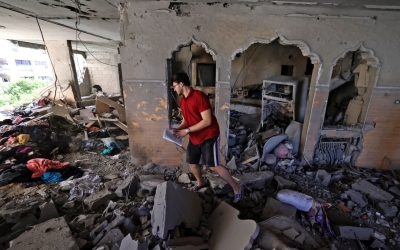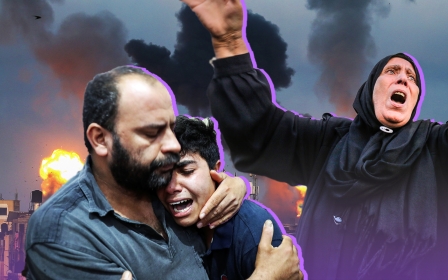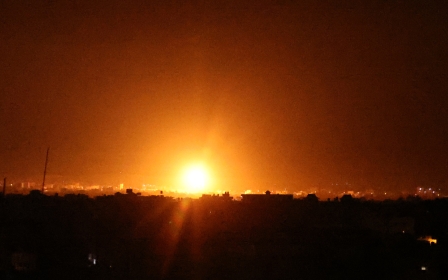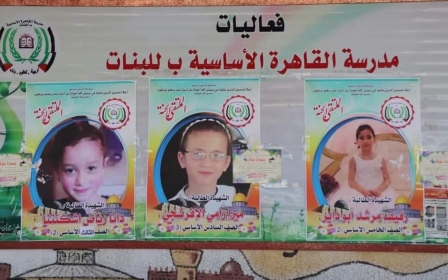Gaza businesses stand on shattered ground months after Israel attacks
Naim al-Seksek is a Palestinian businessman who runs a factory in the Gaza Industrial Zone, one of the safest places in the Gaza Strip to operate a business from - or so he'd thought.
On May 20, his factory became one of the many casualties of Israel’s latest military operation in Gaza.
During an 11-day period in May, Israel launched around 2,750 aerial attacks and 2,300 artillery shells on the Gaza Strip, killing at least 260 people.
“When the Israeli artillery started targeting the Gaza Industrial Zone, there were four guards who saw the fire rapidly spreading due to the raw materials in the factories, they tried to stop it but they couldn’t,” al-Seksek, executive director of the al-Seksek Factory for Plastic Industry, told Middle East Eye.
'[The Gaza] Strip needs up to $485m during the first 24 months following the attack to recover'
- The World Bank's Rapid Damage and Needs Assessment
By the time the Palestinian Civil Defence arrived, at least 15 factories were already destroyed or severely damaged, he said.
New MEE newsletter: Jerusalem Dispatch
Sign up to get the latest insights and analysis on Israel-Palestine, alongside Turkey Unpacked and other MEE newsletters
The 123-acre industrial zone was established in 1996 under agreements with the support of the World Bank, US Agency for International Development (USAID), the European Investment Bank and the European Union, and is home to dozens of Palestinian businesses.
“We never expected that the Industrial City would be targeted, because it is supposed to be protected under the establishment agreements, but the reality was shocking,” al-Seksek said.
“Our factory’s losses alone amounted to $1.2m, most of the stock and a large part of the machinery were completely destroyed. Now even if we were to be compensated for the losses, we would need at least two years to be able to operate normally again.”
According to the Palestinian Ministry of Economy in Gaza, around 1,500 economic establishments were destroyed or damaged during the recent Israeli attack.
In July, the Higher Governmental Committee for the Reconstruction of Gaza announced that the total losses and damages resulting from the attack amounted to $479m.
The committee stated that 33 percent of the damage was incurred by the economic development sector, 61 percent by the housing and infrastructure sector, and 7 percent by the social development sector.
‘I’ve lost everything’
Al-Seksek’s frustration is shared by many business owners across the Gaza Strip, whose operations remained paralysed by the attack’s consequences.
Near the al-Seksek factory in the Industrial Zone is the Abu Iskandar Nylon Factory, which was directly targeted by Israeli incendiary shells and severely damaged.
“The Israeli occupation fired several incendiary shells at our factory, resulting in a huge fire that lasted for five hours due to the inflammable raw materials it contained,” Ahmed Harb, one of the factory's owners, told MEE.
“I’ve lost everything. We will not be able to operate again in the near future. We need hundreds of thousands of dollars to rebuild what was destroyed.”
Harb said that the losses resulting from the attack amounted to at least $700,000, leading the factory’s administration to lay off all its workers.
“Seventeen workers used to work in this factory, all of them depended on their jobs here to make a living and support their families. All of them are unemployed now.
“No factory is safe or protected. In fact, factories and businesses may be part of the main target,” Harb said.
Without operational facilities, al-Seksek said had also lost the ability to provide full-time work for his employees.
“Around 100 people used to work here, now we only have 40 workers who work part-time, either because the departments they used to work at stopped operating, or because the production volume has been reduced to a minimum,” he explained.
Damaged ‘economic psychology’
A Rapid Damage and Needs Assessment, conducted in June by the World Bank, revealed that the attack resulted in roughly $380m in physical damage and $190m in economic losses.
The organisation said Gaza needs up to $485m during the first 24 months following the attack to recover.
But the consequences of the attack go much further beyond the immediate financial losses, said Mohammed Abu Jayyab, a Palestinian economic expert.
“The most affected economic sectors are the industrial, commercial, and agricultural sectors. The damages in these sectors are not only direct material losses, but also strategic losses related to investment safety,” he told MEE.
“The Israeli authorities have continued their procedures against the economic sector in Gaza even after the offensive. Raw materials have been prevented from entering Gaza. Moreover, they have imposed restrictions on the export of products ever since the Israeli blockade began in 2007. Gaza's economic structure is distorted due to the Israeli blockade and successive offensives. The load from the consumer sector now largely exceeds that of the production sector, although Gaza’s market used to compete in the international market before the imposition of the blockade,” he said.
Abu Jayyab said that before the four major Israeli attacks and the imposition of tight restrictions on Gaza, around 160,000 Palestinians used to work in 13 different industrial unions. Today, these unions can only provide 20,000 work opportunities.
But what is affecting Gaza’s economy on the strategic level is the fact that ongoing tensions have deeply impacted the economic psychology of the Strip.
“What is dangerous about the economic structure in Gaza is that there is currently reverse capital flight,” Abu Jayyab explained.
“Well-known businessmen tend to migrate or move their businesses either to the West Bank or to other countries. They operate their businesses there and export their goods to Gaza because it's safer for them than always being uncertain due to the offensives and the tight blockade.”
Targeting the economy
Among the buildings destroyed during Israel’s attack were at least four residential towers that housed dozens of small businesses and media offices. Hanadi tower, one of Gaza’s largest buildings, was the first to be levelled on the second day of the attack, May 11.
“The occupation did not give us enough time to evacuate the valuable equipment in order to reduce the amount of losses, they targeted the tower and destroyed our headquarters with it. Unfortunately, we have lost everything,” said Nehad al-Shanti, owner of a programming and web design company.
Despite their best efforts to resume normal operations as quickly as possible, al-Shanti said many obstacles stood in the way.
The company used to have 36 employees but had to lay off 10 people after its headquarters was demolished in the attack. For the moment, the other 26 employees are working remotely from their homes.
“Our losses amount to around $30,000, and we still need so much time to look for another office and prepare it to be able to operate normally again,” al-Shanti said.
The targeting of the economic sector, including factories and small businesses, as well as the repeated closure of Gaza's borders has continued to push thousands of the coastal enclave's residents into unemployment and poverty.
According to the International Labour Organisation, less than one in every five people of working age in Gaza has a job, while two-thirds of women and young people remain unemployed.
The best scenario is ‘bad’
Although Israel’s Coordination of Government Activities in the Territories (COGAT) announced a series of changes to the policy on movement of people and goods in and out of Gaza, the new procedures remain “far from meeting the needs of Gaza residents and its economy”, according to Gisha, an Israeli not-for-profit organisation that campaigns to protect the Palestinians’ freedom of movement.
On the long list of goods prevented from entering Gaza are the building materials needed for reconstruction following the recent attack.
“The delayed reconstruction also indirectly impacts most of the economic sectors in Gaza. When we talk about the construction process itself, we are talking about 30 different professions that are involved in it, including contractors, construction workers, plumbers, carpenters, etc,” Abu Jayyab told MEE.
“When this process is halted, it means that around 60,000 workers in the construction sector around the Strip are unable to work. Businesses are facing compound losses... The best scenario is bad. Even if all international and local efforts combined succeeded in carrying out their roles perfectly, Gaza’s economic sector would need at least five years to return to its fragile state before the last attack," he concluded.
Middle East Eye delivers independent and unrivalled coverage and analysis of the Middle East, North Africa and beyond. To learn more about republishing this content and the associated fees, please fill out this form. More about MEE can be found here.






